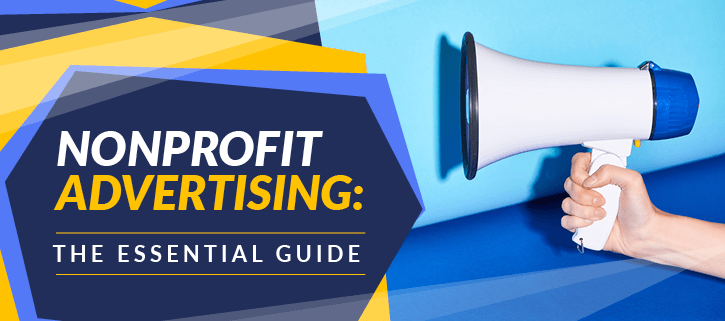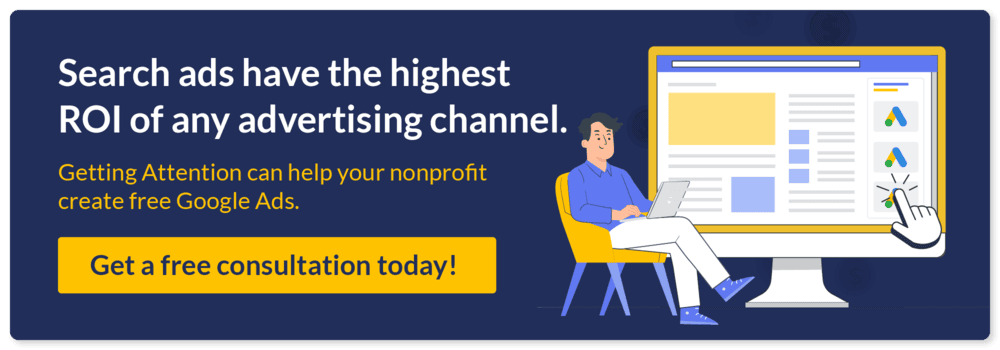Nonprofit Advertising: The Essential Guide (With Examples!)
Nonprofit advertising is critical to spread the word about your organization and earn donations. But while for-profit businesses can afford traditional advertising channels like billboards and commercials, nonprofits with tight budgets might struggle to inspire support for their causes. Thankfully, nonprofits have little-to-no-cost advertising options at their disposal.
To help you create a well-developed nonprofit advertising plan that keeps costs low and success high, we’ll walk you through the following topics:
- Nonprofit Advertising Basics
- The Benefits of Effective Nonprofit Advertising
- The Challenges of Advertising for Nonprofits
- Types of Nonprofit Advertising
- Steps for Creating An Eye-Catching Nonprofit Ad
- 3 Standout Nonprofit Advertising Examples
Effective nonprofit advertising can help your organization increase awareness and accomplish more for your mission. Ready to jump in?
Nonprofit Advertising Basics
Before you can craft a stellar ad for your nonprofit, you need to understand the fundamentals. Let’s take a look at the basic information you need to know!
What is Nonprofit Advertising?
Nonprofit advertising is a specific type of marketing that refers to the paid channels and strategies an organization uses to spread awareness of its mission and projects.
While general mission-driven marketing includes all of the strategies and channels an organization uses to amplify its mission, nonprofit advertising only refers to traditionally paid channels. Regardless, the ultimate goal is the same: to raise more donations, grow a following, and bring attention to your cause.
The Difference Between Inbound and Outbound Marketing
As part of your nonprofit marketing plan, document how your team will promote its cause, balancing paid and free channels appropriately. Doing so enables your team to create promotional materials, stay consistent with branding and goals, and reach your target audience without breaking your budget.
While making this plan, your team should balance outbound and inbound marketing tactics. Here’s the difference between these two types of channels:
- Outbound marketing involves reaching out to the public using paid channels (i.e., advertising) to get them interested in your organization. Examples include print advertising, social media ads, pay-per-click advertising, radio ads, and telemarketing.
- Inbound marketing focuses on creating and distributing unpaid content to draw people into your mission. Inbound tactics can include search engine optimization (SEO), earned social media, blogging, and other forms of content production.
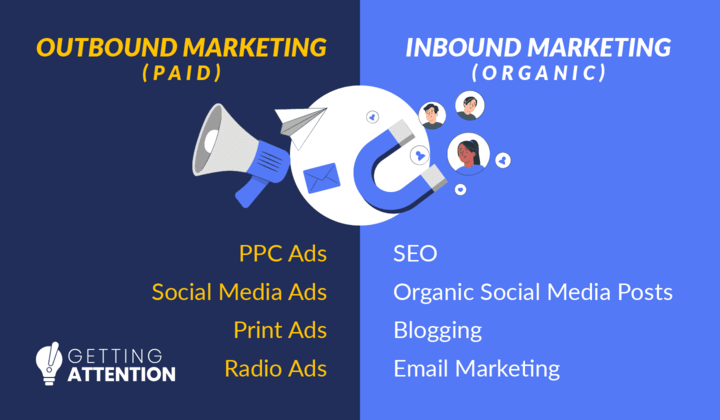
To strike a balance, we recommend using inbound tactics like optimizing your website for SEO or nurturing leads with email marketing. Then, you can advertise your optimized content.
Inbound Marketing Explained
The majority of this guide to nonprofit advertising focuses on outbound advertising, but let’s take a moment to elaborate on inbound marketing and how it can complement your outbound strategy.
Inbound marketing revolves around content generation. What types of content are likely to interest and attract prospective supporters to your nonprofit? This might be a research report on your cause, a podcast with hosts who answer listeners’ questions, or a blog post that dives into a specific topic related to your nonprofit.
After creating this content, inbound marketing follows the principle that interested parties will find it and start the process of becoming supporters. However, very few inbound marketing strategies actually leave it up to chance that interested individuals will just stumble upon their content. Rather, they employ a number of strategies, the chief of which is SEO.
SEO is the process of adjusting your current content and creating new content that is search engine-friendly. By doing so, your content will rank higher on search engine results pages, increasing the chances that potential supporters will click on it. This helps build your brand recognition, drive website traffic, and reach your audience.
Generally, an SEO strategy can be divided into three components:
- Keyword research. An SEO strategy is only effective if it targets the keywords that enough prospective supporters are actually looking up. Consider words, phrases, and questions related to your cause that supporters may enter into search engines. For example, a nonprofit selling professional development courses might target keywords like “continuing education courses” or “online certifications.”
- Content creation. Using the information gathered through keyword research, nonprofits create content focused on the topics potential supporters are searching for. This might be educational content related to recent research, tips for getting more involved, or a product page promoting specific services.
- Technical optimization. Search engines like Google want to promote content that provides users with a positive experience. As such, technical considerations, such as load times, mobile-friendliness, and the number of broken links are factored into SEO rankings.
With a strong SEO strategy, you might reach a point where target keywords for your nonprofit feature your Google Ad as the top result and then more of your content for the organic spots right under it! You might even push the competition off the page and take up more real estate within results. This presents your organization as trustworthy and valuable and increases the chances prospective supporters will click on a link to your site.
Including Advertising in Your Nonprofit’s Budget
One of the limiting factors of advertising is budgetary constraints. That’s why it’s important to establish a detailed budget before each fiscal year to make sure you aim for and maintain a positive ROI.
Try to allocate between 5-15% of your budget to advertising and marketing. As you build this budget, consider applying for grants and seeking other free nonprofit advertising opportunities to reduce expenses.
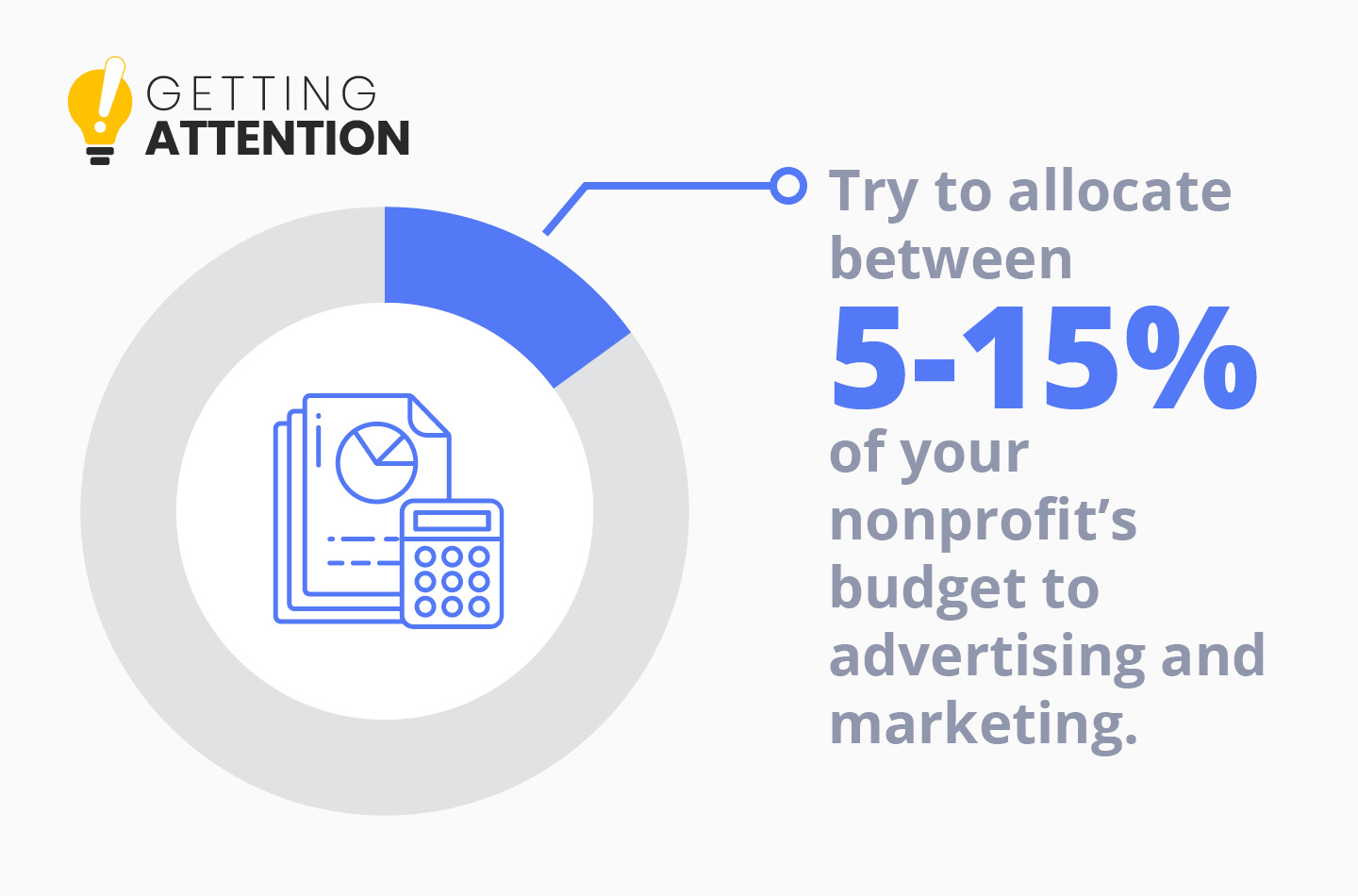
Taking Advantage of Free Nonprofit Advertising Opportunities
While traditionally expensive, advertising platforms recognize the budgetary challenges nonprofits face, so they’ll often provide discounted and occasionally free nonprofit advertising. This can skyrocket the marketing channel’s ROI for your nonprofit.
For instance, Google provides eligible nonprofits with $10,000 in free advertising credits to spend on Google Ads each month through the Google Ad Grant program. This is an incredibly valuable opportunity for nonprofits. According to Nonprofits Source, search ads have the highest ROI of any paid advertising channel at $4.78. With this grant, you can dramatically reduce your spending on advertising and reach new, interested audiences more easily.
Along with the Google Ad Grant, other free nonprofit advertising opportunities include:
- Radio ads: Many nonprofits qualify for free public service announcements on community radio stations due to Federal Communications Commission rules.
- Microsoft Ad Grants: Similar to the Google Grants program, Microsoft offers its own free advertising program that provides up to $3,000 in advertising credits monthly.
- Corporate sponsorships: Thanks to recent corporate social responsibility trends, many businesses want to help nonprofits by sponsoring them. Through media sponsorships, corporations can provide free promotion for your nonprofit.
Due to the popularity of free nonprofit advertising options like these, more and more nonprofits are able to expand their reach through advertising.
The Benefits of Effective Nonprofit Advertising
In a recent year, nonprofits invested 19% more in digital advertising to reach their audiences. That indicates they’re experiencing worthwhile advantages from it. By crafting a smart nonprofit advertising plan, you’ll experience a ton of great benefits, including:
- Raise brand awareness. Nonprofit advertising channels allow your team to reach a broader audience than word-of-mouth alone. Through compelling ads, you can connect with potential supporters and stay front-of-mind for existing donors.
- Generate high-quality conversions. If your ad is powerful enough, you can convert an ordinary viewer into a valuable supporter. You might shoot for conversions like donations, volunteer sign-ups, contact form completions, event registrations, or shares to social media sites.
- Grow and maintain thought leadership. Advertising can position your nonprofit as a thought leader in its field. If your nonprofit consistently releases relevant news and industry updates, you’ll become a trusted resource.
- Major returns on low-cost efforts. As we mentioned, nonprofits tend to see a high return on their outreach efforts, thanks to affordable and free nonprofit advertising options like the Google Ad Grant.
Advertising is too good to pass up. Even if you don’t have the time you’d like to dedicate to creating your ads, an expert can step in to help out. For example, the experts at Getting Attention understand everything there is to know about advertising on Google. With low prices, they can help you manage your Ad Grant account and craft winning ads that drive more revenue for your cause.
You won’t be able to accomplish the above without strategic advertisements and a well-crafted plan, though. We’ll explore some steps for crafting winning ads a little later.
The Challenges of Advertising for Nonprofits
Even with these great benefits, there are a few challenges you should familiarize yourself with. Knowing what to expect will help you combat these challenges before they arise:
- Potentially negative donor reactions. A lot of people already have a bad taste in their mouths thanks to for-profit advertising. Plus, many donors want to see their contributions go directly to your nonprofit’s mission, as opposed to the marketing needed to achieve that mission.
- Authenticity and establishing connections. Storytelling is a key component of nonprofit marketing that can be lost in advertising if you’re not careful. Make sure you’re producing authentic content that communicates your nonprofit’s story and why it’s vital that viewers get involved.
So, how can you get ahead of these challenges? Start by choosing affordable and free nonprofit advertising channels and strategies that won’t blow your budget out of the water. From here, make sure your ads feature inspirational content in an authentic tone, rather than being too salesy.
Many organizations also turn to external agencies to manage their ads and overcome common challenges. Just be sure to choose an agency that specializes in your sector. For example, a church might hire a church marketing agency that understands the unique needs of the religious sector and knows proper messaging and terminology.
Types of Nonprofit Advertising
There’s no one-size-fits-all approach to nonprofit advertising. What works for one organization might not work for another. The good news is that there are plenty of options out there! Let’s explore seven nonprofit advertising channels you can use.
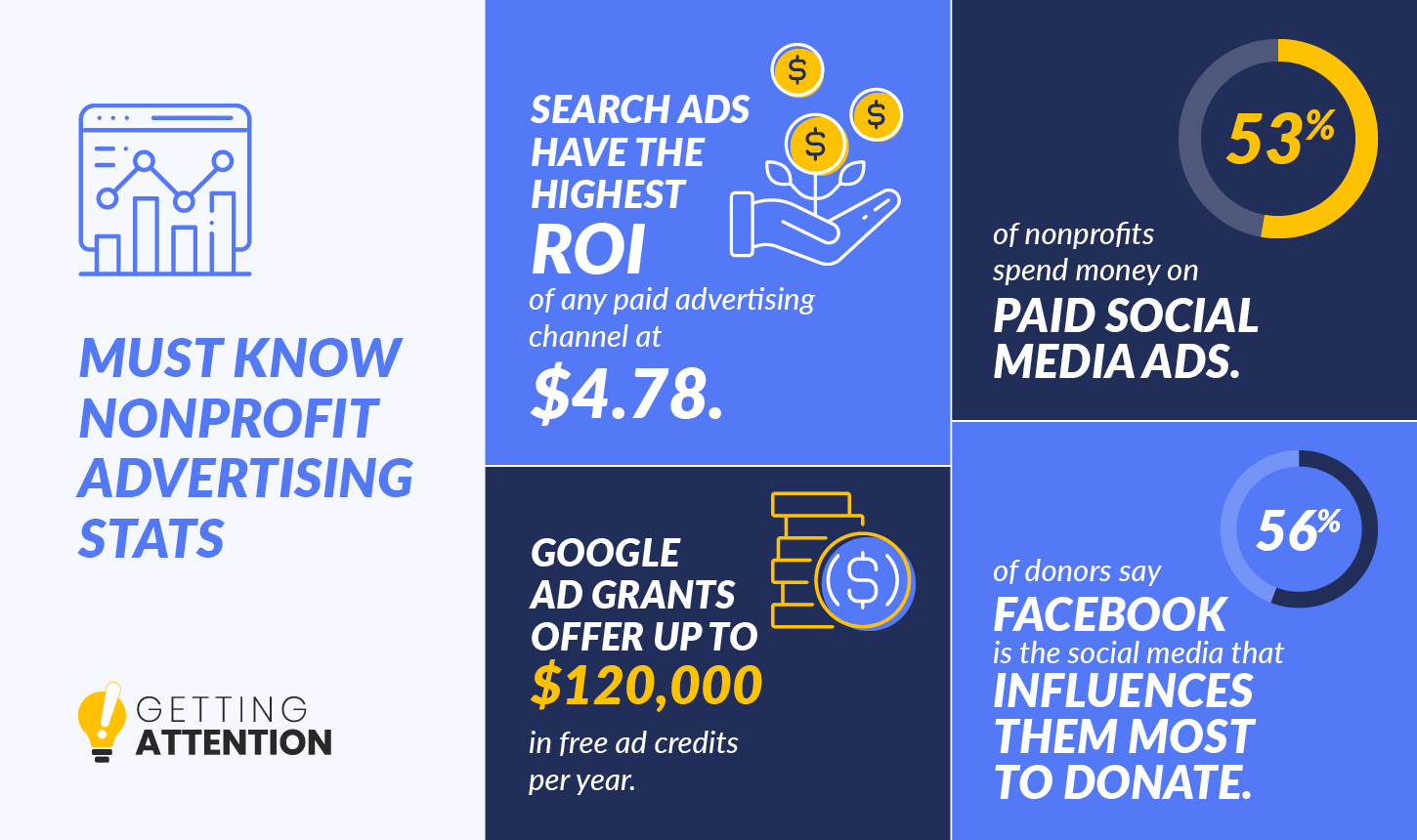
Google Search and Display Ads
Google Ads allows you to advertise your mission when users search for relevant keywords. Paid search advertisements appear on the search engine results pages corresponding to your chosen keywords on Google. Meanwhile, display advertisements promote your organization to users watching YouTube videos, checking Gmail, or browsing sites within Google’s display network.
The average small business that uses Google Ads spends between $5,000 and $12,000 per month on paid search campaigns. That’s $60,000 to $150,000 of marketing expenses every year.
To make this opportunity more accessible, Google provides eligible nonprofits with a $10,000 monthly stipend to spend on paid search ads. This program is called Google Ad Grants and can be a real game-changer for your nonprofit advertising efforts.
While regular Google Ad accounts must pay per ad-click, Google Ad Grant participants can publish ads for free through the program. These ads enable your nonprofit, whether it’s a church or a cultural organization, to appear on Google and get in front of qualified prospects searching for topics related to your mission.
The ideal Google Ad Grant candidate has a high-quality website that effectively serves its audience and promotes its mission. By leveraging Google Ad Grants for nonprofits, your organization can accomplish the following:
- Drive more traffic to your website
- Increase online conversions, like donations and volunteer sign-ups
- Connect with new supporters and retain existing ones
- Leverage conversion-optimization tools like responsive search ads
- Analyze and track your campaign performance
As long as your organization stays compliant with the eligibility requirements, your grant will automatically renew each month. For tailored help, feel free to contact our team at Getting Attention. We work with nonprofits to create winning ads that champion their cause and garner meaningful attention.
Nonprofit Facebook Ads
Facebook remains one of the most popular social media platforms for interacting with and donating to nonprofits. In fact, 56% of donors say that Facebook is the social media platform that has the largest impact on their decision to donate.
Facebook offers a range of advertising solutions for nonprofits that make it easy to take advantage of this opportunity. With their nonprofit-oriented tools, you can:
- Create and run ad campaigns
- Select a target audience
- Utilize on-site conversion optimization to improve ads
- Track performance with easy-to-read reports
- Encourage supporters to host peer-to-peer birthday fundraisers to expand your organization’s reach
Be sure to include clear calls to action in your Facebook ads, and consider including buttons to drive users to your donation page or other key landing pages on your websites.
Social Media Advertising
According to the 2023 Nonprofit Tech for Good Report, 87% of nonprofits regularly use social media in their digital marketing and fundraising strategies, while 53% of those spend money on social media ads.
There’s a good reason for this! Social media has an incredible reach and is estimated to reach 5.8 billion users worldwide by 2027. Tap into this audience by implementing social media ads on the following platforms:
- Instagram: Instagram ads appear throughout the app in users’ feeds, stories, and explore pages. They look similar to normal posts but contain a “sponsored” label. They also have more features than a normal post like links, CTA buttons, and product catalogs. Track Instagram ad performance with insights so you can adjust your strategy to improve over time.
- Twitter: Twitter allows you to choose your target audience and amplify your message. Promoted ads reach a wider group of users and are the perfect way to share updates and increase visibility.
- TikTok: TikTok for Good helps nonprofits promote their causes on the increasingly popular video sharing platform. Our guide to TikTok for nonprofits explains the different types of ads on the platform, including Promoted Hashtag Challenges, Branded Effects, TopView Ads, and In-Feed Ads.
When using social media to advertise, keep an eye on what’s trending and focus your messaging. Use real stories and photos from the communities that you’ve helped and the impact you’ve had on individuals to drive the point home.
Community Radio
Your nonprofit might qualify for free public service announcements on community radio stations thanks to the Federal Communications Commission. They require radio stations to allot a certain amount of radio time to nonprofit organizations.
However, radio messages must be formatted as announcements rather than ads, meaning you can’t make direct solicitations. You can still inspire action by sharing impact statistics or directing users to your site or social media where they can learn more. If your social media posts or website are optimized, visitors may inevitably click the ‘Donate’ or ‘Volunteer’ button.
Direct Mail and Print Ads
Although the world has transitioned into a digital-dominant space, print isn’t dead. Direct mail describes the hard copy requests for funds mailed to your existing supporters and prospects. These solicitations arrive in your supporters’ mailboxes and provide a tangible connection to your organization.
There are plenty of benefits to direct mail and print campaigns, including:
- Cost-Effectiveness: Print campaigns are highly flexible, meaning they’re budget-friendly, too.
- Increased Action: Print is an effective way to spark meaningful action. Most print readers take some form of action after viewing a newspaper ad.
- Targeted Audiences: Print marketing is targeted to an audience already interested in your mission. Generally, you should only mail newsletters, magazines, or event registrations to subscribed supporters.
An awful lot of people prefer receiving mail from the nonprofits they support. It comes across as more meaningful, even though you’re still advertising your mission.
Retargeted Advertising
Also called remarketing, retargeting is a form of online advertising that enables you to target users with ads based on their interactions with your nonprofit’s website. These ads can work with pretty much any online marketing channel, like social media or email.
Nonprofits can leverage the power of retargeted advertising in some impactful ways, such as:
- Abandoned donations. Retarget those who left your donation page before actually giving. This strategy works well, because you’re targeting people who were already considering donating. Think about why someone might not have followed through before creating your ad. For example, maybe they didn’t know enough about your cause. In that case, your ad might feature a captivating success story.
- Event reminders. Want to drive higher attendance for your upcoming event? Set up a retargeting ad campaign for anyone who doesn’t complete their registration. If someone exits the page to check their schedule before registering, this can be a great reminder to come back.
Using retargeted advertising allows you to achieve a high level of precision when reaching out to prospects. In turn, you can convert more users who were on the fence about supporting your work.
Sponsored Retargeting
Sponsored retargeting is when another business or organization that sponsors your nonprofit purchases ads from you. Often, these ads are co-branded, featuring elements of both the sponsor and nonprofit’s brands.
A company might purchase sponsored retargeting for a couple of reasons:
- They want to strengthen their reputation by being associated with your nonprofit.
- Their audience aligns with yours, and they want to promote their services directly to your supporters.
As with any corporate philanthropy initiative, the benefits go both ways! Your sponsor might share the ads on their platforms, too. This can bring exposure to your nonprofit and its sponsors.
Influencer Ads
Social media influencers who have an affinity for charitable missions can partner with their favorite nonprofits to promote the causes near to their hearts. This type of nonprofit advertising works well because influencers have loyal audiences, they’ve built credibility, and their followers trust what they have to say.
Larger nonprofits might have room in the budget to pay a celebrity, while smaller organizations might turn to an influencer within their circle, like a board member, politician, or local celebrity. Either way, partner with those who have positive reputations and values that align with your cause. Then, create co-branded marketing collateral, making it easier for the influencer to share it with their followers.
Bonus Tip: Organic Search
While the Google Ad Grant will significantly boost your organization’s presence on search engines, incorporating SEO strategies can enhance your results even further.
We’ve already touched on the basics of creating an SEO strategy, but a few other tips to keep in mind include:
- SEO is a long-term marketing strategy. Creating valuable content, getting that content ranking in Google search results, and earning a dedicated stream of page visitors all take time. On average, a dedicated SEO strategy can take six months or longer to see results.
- SEO is better for certain types of content. Just as you can promote any page on your website with the Google Ad Grant, you can also plan your SEO strategy to target any keyword. However, SEO is better at certain types of marketing campaigns than others. Specifically, SEO is useful for nonprofits with product and service offerings because users searching for products and services are likely ready to make a purchase. In contrast, fundraising requires raising awareness and building relationships first, which can be tricky to do in a 180-character ad.
- Prioritize conversions. SEO boosts search engine traffic, but the real measure of success is conversions. A conversion might be a product sale, event registration, or any other action you want supporters to take. Use tools like Google Analytics to track visitors and see if they are landing on your keyword-optimized content. Then, dig a little deeper into your data to see if that increase in traffic corresponds to an increase in conversions. If it does, then your SEO strategy is working!
If you’re ready to dive into SEO, consider getting a little help to eliminate the learning curve. Just as there are consultants for the Google Ad Grant, there are also SEO marketing consultants for nonprofits. The top agency we recommend is Nexus Marketing.
Nexus Marketing works with nonprofits to promote their products and services through an intensive SEO strategy that involves content creation, cross-blogging opportunities, webinars, and more. Their approach lays the foundation for turning search engine traffic into a long-term revenue-generating source. In the meantime, they can also earn your nonprofit short-term wins by getting your organization in front of new audiences with their impressive network of over 500 partners in the nonprofit space.
Steps for Creating An Eye-Catching Nonprofit Ad
Your marketing efforts should be ongoing to maintain supporter engagement, bring in consistent donations, and ensure your work is relevant. Here are 6 steps that your team can take to create an effective advertising plan:
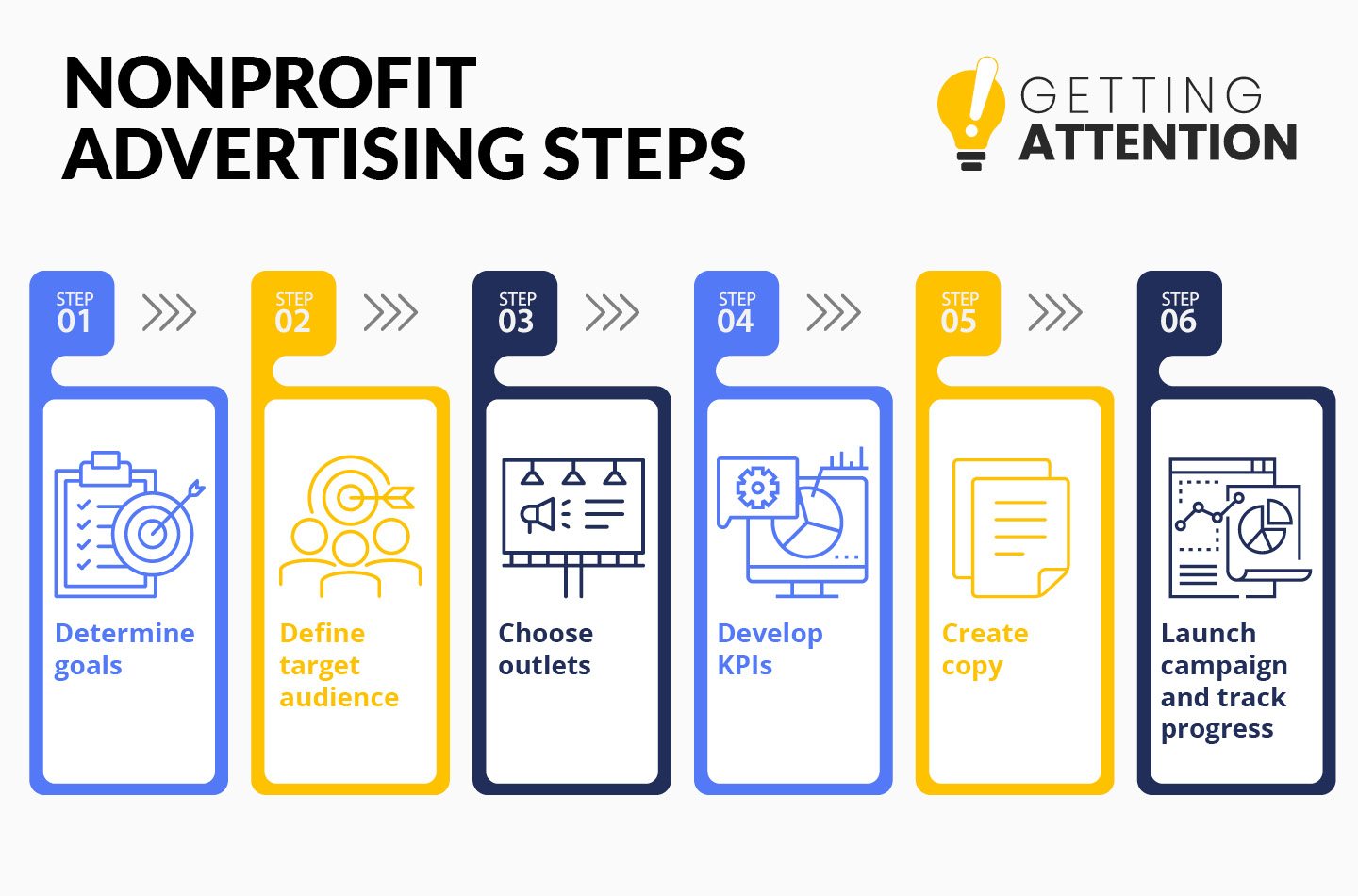
1. Determine goals for your nonprofit ads.
First, consider what your organization hopes to accomplish. When creating goals, it’s helpful to use the SMART method:
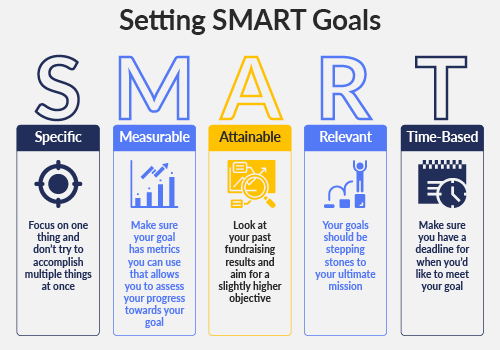
- Specific: Your goal should be as narrowly-focused as possible. For instance, a specific goal could be, “We will increase subscriptions to our e-newsletter.”
- Measurable: Goals are useful when you can quantify their success and progress with a metric. If you notice rates dropping, simply adjust your strategies. “We will increase e-newsletter subscriptions by 50%.”
- Attainable: Don’t set lofty, unrealistic goals. Look at your past digital fundraising results and aim for a realistic objective. “We will increase e-newsletter subscriptions by 30%.”
- Relevant: Your goals should be stepping stones to your ultimate mission. Make sure that every goal you set is tied to a broader marketing goal. “We will increase e-newsletter subscriptions by 30% to retain more donors.”
- Time-based: Objectives should have a deadline and be monitored regularly. “We will increase e-newsletter subscriptions by 30% by the end of the third quarter to retain more donors.”
Using this method, your goals will drive meaningful conversions and support your nonprofit’s mission. Use our SMART Goals Template to start planning your advertising goals today.
2. Define your target audience.
For each campaign or event you plan, you should have a specific audience in mind. This audience can include new donors, existing donors, lapsed donors, major donors, and more. Start by collecting the following data to determine your target market:
- Age: By dividing your ad strategy into specific age groups, you can ensure that you’re getting through to the right audience. A study by the USPS found that ads designed to elicit an emotional response were more effective with younger consumers, while those that describe a product’s function, especially in print format, were relatively more effective with older adults.
- Location: Implement geo-targeting to provide the most relevant ads to people in your area. Geo-targeting is the practice of targeting visitors online with localized or location-appropriate content based on a visitor’s geographic location.
- Employment Status and Employer: An individual’s business affiliations can give you an idea of their net worth, potential connections, and ability to donate. Plus, if they work for a company with a matching gift program, you can reach out to begin the gift match process.
- Communication Preferences: Keep communication preferences in mind when choosing between print, digital, and telemarketing. For instance, young professionals 18 to 34 have one of the best response rates to direct mail campaigns.
These insights can answer the who, what, why, and where of potential supporters. Once you define your audience and their preferences, you can tailor your marketing efforts to reach them and prompt them to take action.
3. Research and choose nonprofit advertising outlets.
Once you determine your goals and define your target audience, it’s time to choose an advertising outlet. Look back at the types of nonprofit advertising we discussed earlier to choose channels that work for you and your target audience.
We recommend using a multi-channel approach to marketing. This allows you to use a variety of strategies that work together towards a common goal.
4. Develop key performance indicators.
Key performance indicators (KPIs) are metrics that organizations use to measure the progress of their defined goals. KPIs can help your team gauge progress, make informed decisions, and turn metrics into actionable insights.
We’ve outlined a few top advertising KPIs to follow, using the example of digital advertising:
- Impressions: Impressions refer to how many times your ad unit was displayed to a user. This metric is related to the top of the marketing funnel and speaks directly to brand awareness.
- Click-through-rate (CTR): This measures how relevant your ad is to your target audience. If the CTR is low, this means the ads aren’t meeting the searcher’s intent for the target keyword.
- Bounce Rates: A bounce rate is the percentage of visitors who enter the site and leave (“bounce”) rather than viewing other pages. This can help you understand the quality of your website and if it’s valuable to visitors.
- Conversion Rate: This is the number of web visitors who complete a desired goal, like making a donation or signing up for a newsletter. If your conversion rate is high, your marketing strategies are working.
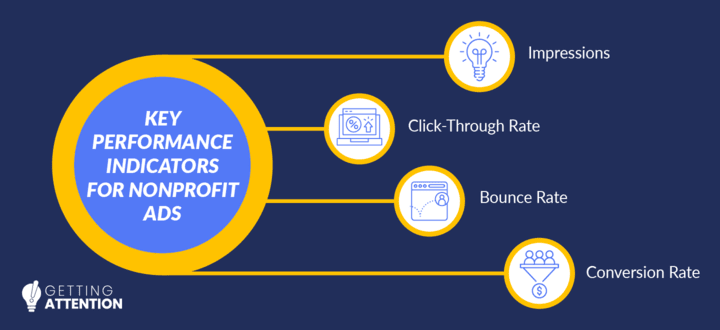
These are only a few of the trackable KPIs for digital ad campaigns. It’s important to know your platforms and the types of data that each offers.
5. Create your ad copy.
One of the last steps is content creation. When creating advertising content, keep the following best practices in mind to ensure your ads stand out:
- Improve relevance. Posting regularly increases engagement and keeps your ads relevant. Another way to stay relevant is to use your supporter’s most popular search query keywords in your ad titles and text.
- Showcase impact. Make your ads engaging and insightful by showing your organization’s impact. This will keep donors, volunteers, and supporters invested in your mission and encourage them to heed your calls to action.
- Include calls to action. Call-to-action (CTA) buttons prompt readers to show their support and take initiative to further your mission. Keep phrases short and compelling.
- Add compelling visuals. Images, graphics, and videos can spark an emotional reaction in readers and help them to understand complex topics. Ensure that colors and fonts are consistently formatted and visuals are high quality.
- Make the most of the ad space and characters allotted. Use the full allotment of headlines and descriptions to make your ads appear larger, increasing the click-through rate and number of visitors arriving on your website.
These quick, simple tricks will help your campaigns reach the right audiences and drive meaningful action. Now you’re ready to launch campaigns!
6. Launch your nonprofit advertising campaign and track progress.
After you’ve completed the steps above, it’s time to launch your ad campaigns and track progress against concrete, measurable benchmarks. Monitoring your performance is critical. It reveals what works, what doesn’t, and how to improve the effectiveness of future campaigns.
Start by accessing your campaign data and downloading reports. Focus on the KPIs that relate to your campaign goals. Then, compare multiple metrics to find where leads drop off. For example, if the conversion rate for an ad campaign is low, you may need to make the CTAs more attention-grabbing.
3 Standout Nonprofit Advertising Examples
Let’s take a quick look at three advertising campaigns that will spark inspiration for your team. If you want to see more campaigns in action, check out our extended list of nonprofit advertising examples.
Breast Cancer Research Foundation
Type of Nonprofit Advertising: Google Ad
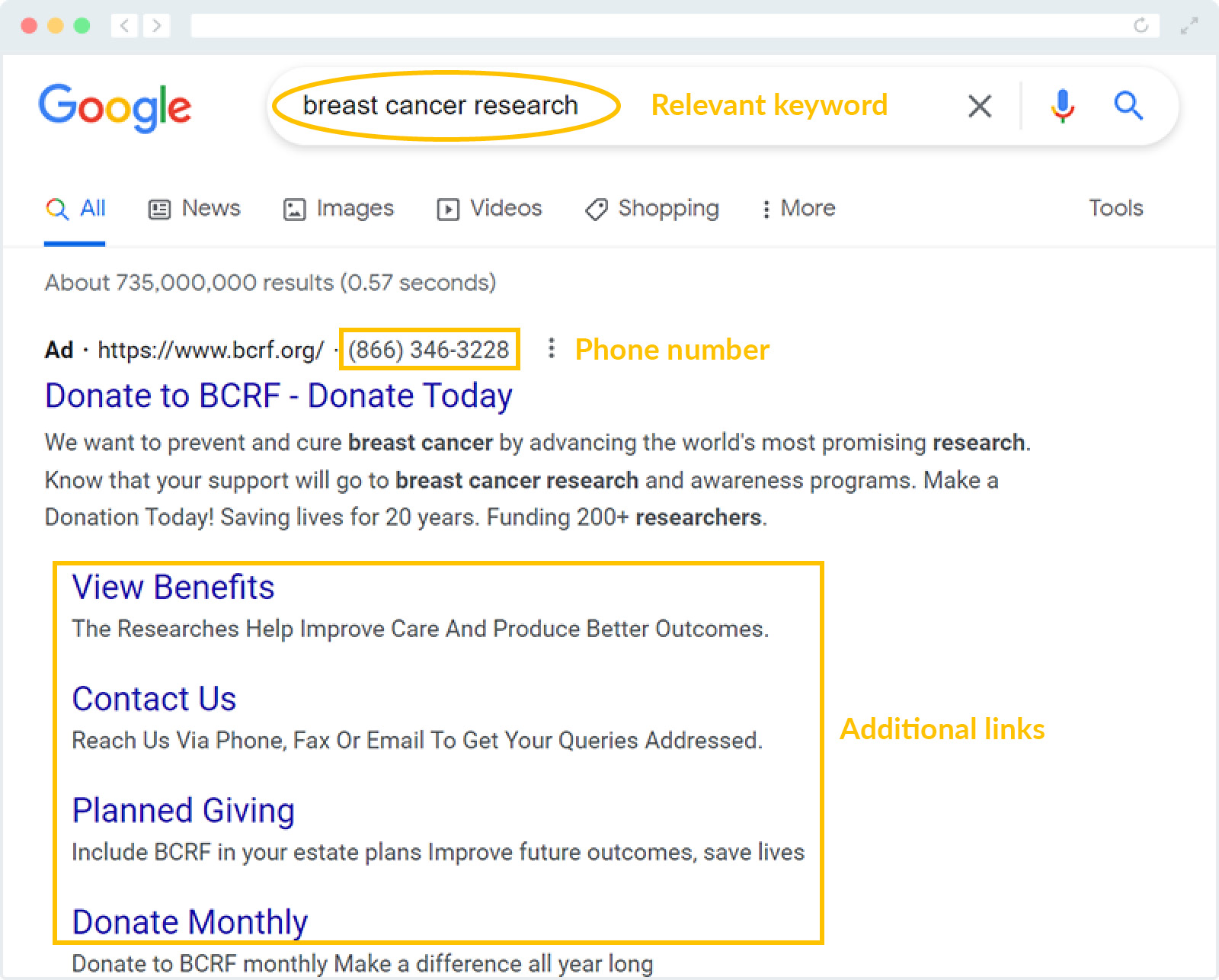
In this example, the Breast Cancer Research Foundation (BCRF) created a Google Ad campaign that targets terms related to “breast cancer research.” Using an inspirational and urgent tone, they establish a sense of trust with users and direct readers to the most important pages on their site.
As we mentioned, any eligible organization can tap into this nonprofit advertising channel by applying for the Google Ad Grant. Every month, the grant automatically renews, giving you $120,000 in ad credits each year.
Notice how BCRF also built out their ad with additional links and their phone number, giving users more ways to engage. This is a more technical strategy that you might turn to an expert Google Ad Grant agency to use.
CARE
Type of Nonprofit Advertising: Facebook Ad
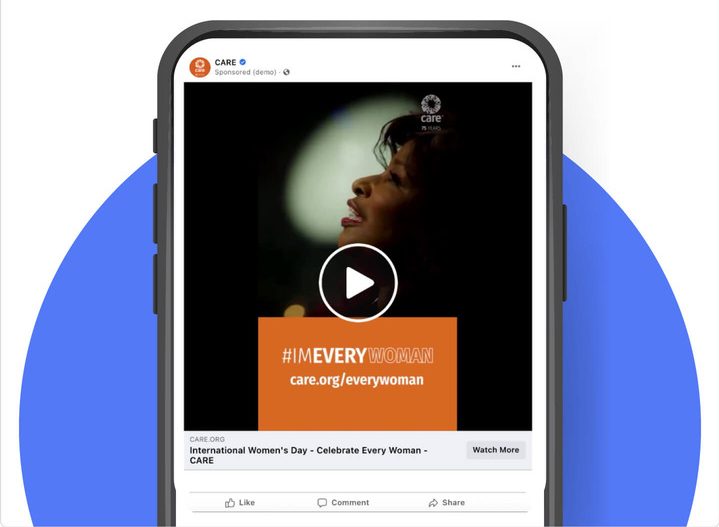
In partnership with Procter & Gamble, CARE created a video ad campaign for International Women’s Day. They were the 2nd top-performing audience in terms of video completion rate (VCR) and engagement across the entire platform. They also pushed the same ad campaign on Instagram, resulting in some incredible statistics across both platforms:
- 2.9 million impressions (total post views)
- 1.7 post engagements (video views, comments, reactions, shares, and clicks)
- 10.4K clicks to care.org/everywoman
- A VCR of 2.08%
This is a great nonprofit advertising example to model your campaign after, because it asked users to complete the low-effort task of watching a video. Short video ad campaigns can be a convenient way to hook users and inspire them to take action.
God’s Love We Deliver
Type of Nonprofit Advertising: Instagram Influencer Advertising

This nonprofit advertising example shows just how easy it is to tap into influencer marketing. God’s Love We Deliver strives to alleviate hunger and malnutrition among people living with serious illnesses. To spread the word about this mission, their marketing director cleverly asked the organization’s supporters to decorate a plate of cookies to be sent to those in need and promote that on their social media pages.
This yearly campaign brings attention from well-known influencers, especially because they make it so easy to get involved. They send sugar cookies and decorating kits to influencers for their annual holiday campaign, and they send cakes and decorating kits for their clients’ birthday fundraiser campaigns.
More Nonprofit Advertising Resources
Effective advertising can fuel your nonprofit’s impact. Best of all, you can leverage free nonprofit advertising, making it easy to get everyone on board. It’s no secret that our favorite option is the Google Ad Grant.
When you partner with a Google Ad Grant professional like Getting Attention, we’ll make sure you have a strong digital marketing strategy. Our team of experts offers free consultations and resources to help your organization expand its reach. We’re here to champion your nonprofit’s digital campaigns.
If you want to learn more about nonprofit advertising, explore these additional resources:
- Crafting a Nonprofit Marketing Plan: Key Tips & Channels. A nonprofit marketing plan is the best way to communicate your mission and reach supporters where they are. Learn more here and download our free template!
- How to Apply for Google Grants: Easy Steps for Approval. Google Ads is an effective and free nonprofit advertising method. Learn how to apply for Google Grants and secure your $10,000 in free funding each month.
- 40+ Marketing Ideas for Nonprofits to Spread Your Mission. Looking to expand your marketing strategies? Check out this expansive list of ideas from Double the Donation!
